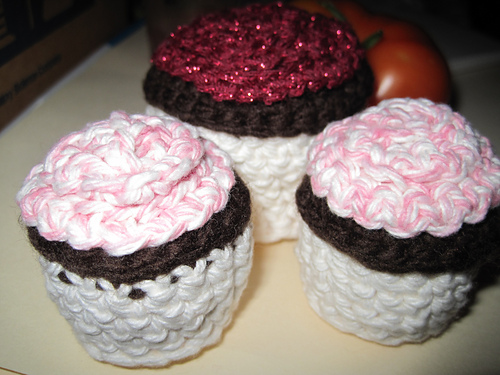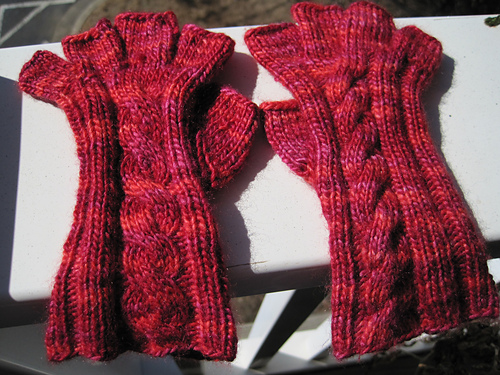As mentioned in my previous posting, I've been working on finger
tipless gloves. There seemingly aren't too many patterns out there for such an occasion. It should also be noted that I have unusually small hands (about 7 inches [18.5 cm] thumb-to-pinky spread, my palm being just about 3 inches [7.5cm] across). And I wanted something that would work for me to be warm, but still leave my fingers free to type as my job requires a great deal of keyboard useage, but my fingers themselves were still getting chilly. I call the tipless fingers
nubbins.
Voila!
Through the use of a couple of free patterns, some general knowledge, and hopefully a bit of ingenuity, I've managed to create myself gloves that suit me, but might also suit others.
First, I want to give a great deal of credit to
Mom's Cabled Mitts, whose free pattern on ravelry was the base of my gloves quite obviously. My pattern directions, however, are going to focus more on the finger portion.
Tools:
For the body: US size 5 (3.75mm) circular needle (dpns are also fine, but I did mine on a circular)
For the fingers: US size 3 (3.25mm) dpns (for this, I'd say dpns really ARE a necessity)
Stitch markers
Stitch holder, scrap yarn
Cable needle (or you can probably use one of the dpns from the fingers, but I had a cable needle)
Yarn:
Malabrigo Silky Merino, colorway amoroso. I used less than one skein, but I'm not sure on the yardage. (Picked up from Eat.Sleep.Knit., whose shop is linked on the sidebar.)
Skills:
knit, purl, picking up stitches, casting on stitches, cabling (which I'll explain a bit), knitting in the round
Cast on: 40 stitches in your preferred round method.
If you want to follow the instructions for the cabling section, you'll need to have stitches 17-24 on the same needle/side of the circular as one another. These 8 stitches will be knit in the first few rows.
I can't emphasize enough that you should check out Mom's Cabled Mitts (for nonRavelers, I've used a direct pattern link here) if you just want to know how to make this style without the fingers. However, I did make SOME changes to the actual cabling/pattern in making mine, so I'm transcribing that here.
Okay, ready? Here's what I did!:
P1, (K3, P2 rib 3x), K8 (
this is for the cabling section, if you just want ribs, then you can continue with the K3, P2 rib pattern!), (P2, K3 rib 3x), P1.
Note that, if you're using a circular, after the K8 you should begin working down the opposite side.
Repeat the setup rib pattern -- P1, (K3, P2 rib 3x), K8, (P2, K3 rib 3x), P1 -- for a grand total of 5 rows.
Row 6 is the cable row. Repeat all as-before except cable the K8 section, slip the first 4 onto a cable needle, knit the next 4, then slip the skipped 4 back onto the original needle and knit 4.
Per Mom's Cabled Mitts pattern, I followed the advice to create the mirror image cables. On the right-hand glove, I put the cable needle behind my knitting; for the left-hand glove I pulled it to the front.
For the next 7 rows (rows 7-13), I continued the original rib pattern P1, (K3, P2 rib 3x), K8, (P2, K3 rib 3x), P1.
Row 14 is another cable row.
Rows 15-20 are in the original rib pattern. (
Note: This is only
SIX repeats of the original rib, I made the mistake and didn't notice it until later; you can feel free to make this seven, but I went with it throughout the rest of the glove)
Row 21 is another cable row.
Rows 22-28 should follow the original ribbing (we're back to seven repeats here)
29 is another cable row.
After row 29, it's time to create the thumb gusset. This term sounds more daunting than the actual process, but I did do this
slightly differently than the instructions from Mom's Cabled Mitts.
Note: Placement of the thumb gusset is the ONLY difference in the instructions for the left- and right-hand thumbs.
Right hand side:
Row 30, we're going to knit in pattern (except for placing two stitch markers).
Place as follows: stay in pattern up through the cable section, after the cable, knit the ribbing once (P2, K3, P2) and then place markers on either side of the middle of the next three knit stitches (K1, PM, K1, PM, K1), then continue to the end of the row.
Left hand side:
Row 30, we're going to knit in pattern (except for placing two stitch markers).
Place as follows: After you knit the ribbing once (P1, K3, P2), then place markers on either side of the middle of the next three knit stitches (K1, PM, K1, PM, K1), then continue to the end of the row.
For the next 5 rows (31-35) we're going to
cast on twice in between the markers; once immediately after the first and once just before the last - there will be a lace edging to the thumb gusset as a result. All stitches between the markers should be knit. There should be 11 stitches between the two markers at the end of row 35. The rest of the stitches should continue in pattern.
On row 36, cable the cable section (
Note: Again, only six repeats of the original rib instead of seven, as in row 20), and cast on one more set of increases in the thumb area, making 13 stitches between the two markers.
Rows 37 and 38, knit in pattern (with the K8 section not cabled).
At row 39, you'll slip the yarn in between the two markers onto scrap yarn or a stitch holder and cast on 1 stitch to replace the original middle knit of the K3 section in the rib. Otherwise, the knitting continues in pattern.
Rows 40-42, continue in pattern. (
Note: This is again only 6 repeats, but as noted I have small hands, you may want to add another row here.)
Row 43, cable.
Rows 44-48, continue in pattern.
After row 48, you're done with the hand portion (and the references to Mom's Cabled Mitts). It should come up to just below your fingers, if it doesn't, I'd take the notes about the number of repeated rows between cable patterns into account, since there are two cables before which you could add a row (see notes, rows 36 and 43), which should get you to the length you need for your hand. Alternately, of course, you could continue the pattern for additional rows.
Also after row 48, you're going to want to slip the hand stitches onto scrap yarn or stitch holders. From this point we'll be working from the pinky inward toward the thumb (though you can feel free to work the thumbs first if you prefer!) attaching each finger to the previously knitted one by picking up stitches.
Time to make the nubbins!
Pinky:
Note: You can actually pick up your stitches wherever you like, but I find that I like to know which stitches I should be using for the pinky, etc. This is just what I found looked 'right' to me. Essentially, you're grabbing the outsides from stitches that are already there on the glove and casting on for the new interior stitches.
When looking at the
right side (this'll be turned inside out as you knit it, so be careful with this instruction, you're going to want to keep knitting inside-out for this) of the right glove [on the left glove, just do the mirror image of this]
you'll see (left to right) the cable section, a P2 section, and then another knit section.
Leave alone the first knit stitch of the three in the section, but pick up the next four stitches with your first dpn. Pick up the next four stitches on your second dpn. This will create the top/side/bottom of your pinky finger. On your third dpn, cast on 4 stitches.
Knit around the pinky for 9 rows (12 knit stitches) and bind off.
This is fairly loose on me, so it should suffice for people of most finger sizes.
Ring:
Working your way toward the thumb, pick up the next 6 stitches on the front on your first dpn and the next 6 stitches on the back on your second dpn. (If you have 5 dpns in this size, it'll come in handy, but if not -- I didn't -- you can reallocate these stitches as necessary after they've all been picked up.) On a third dpn, pick up about 6 stitches from the pinky. On a fourth dpn (or the end of the first or second), cast on 4 stitches. (22 stitches total.)
Knit a total of 10 rounds: on the first round, decrease twice (preferably on the pinky or bottom sides, rather than the top; 20 stitches). On the second round, decrease again, three times (17 stitches). Continue for the remaining 8 rounds knitted, then bind off.
(
Note: If I had this to do again, I would only have cast on 2 stitches instead of 4 in the middle section for this finger, but, because I was done with it before I realized how large this had made the finger, I duplicated the work on the other hand.
I recommend only two stitches, thus eliminating TWO of the total decreases. You'll see how this works on the middle finger.)
Middle:
Pick up the next 5 stitches along the front of the glove on your first dpn and the next 5 stitches along the back of the glove on your second dpn. Pick up 6 stitches from the ring finger on a third dpn. Cast on 2 additional stitches to either the first or second dpn. (18 total stitches)
Knit a total of 12 rounds. On the first round, decrease twice (again, preferably on the interior/bottom of the fingers) for a total of 16 stitches. For the remaining 11 rounds, knit. Then bind off.
Pointer:
Pick up the next 5 stitches from the front of the glove on your first dpn, the next 5 stitches from the back of the glove on your second dpn, and 6 from the middle finger on your third dpn. S
ince we're now connected on all sides, there's no need to cast on any additional stitches on this finger. As a result, there's also no need to decrease on this finger.
Knit 9 rows and bind off.
Thumb:
Now that you've done all your other fingers, the thumb should be simple. Pick up all the live stitches from your scrap yarn/stitch holder (13) and ~6 stitches from the interior of the glove.
Knit 3 rows.
Row 4: decrease 3x around thumb (going from 19 stitches to 16).
Rows 5-9, knit.
Bind off.
Now, weave in all your ends, stitch up any holes (I had a lot of stitches picked up on the interiors so as to make the holes as small as possible, or eliminate them entirely if possible, so you may not have many to close up - fingers crossed!) and block as you'd like, and they're ready to wear!
If there's anything that's leaving you lost and confused, please let me know and I'll do my best to clarify.


















